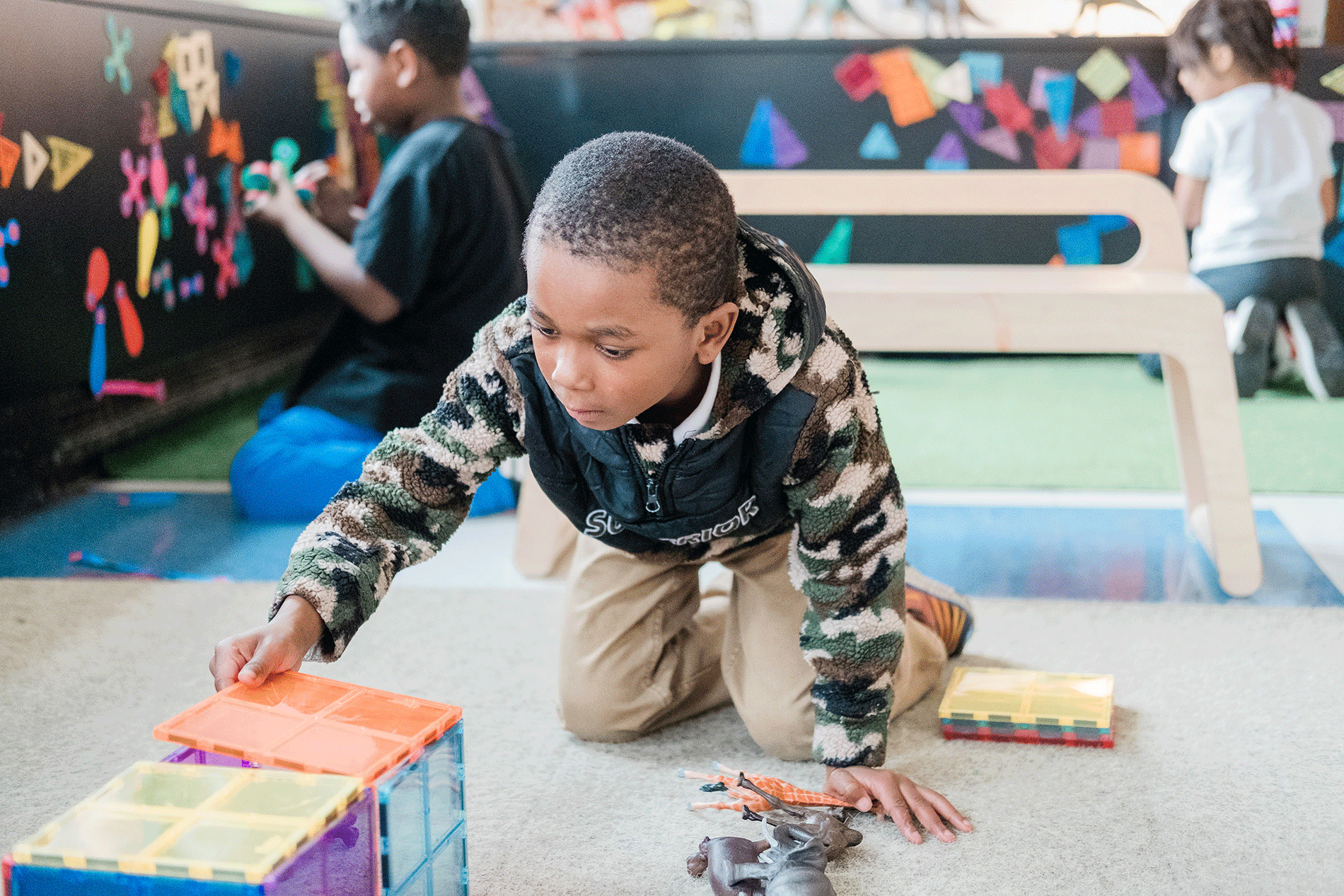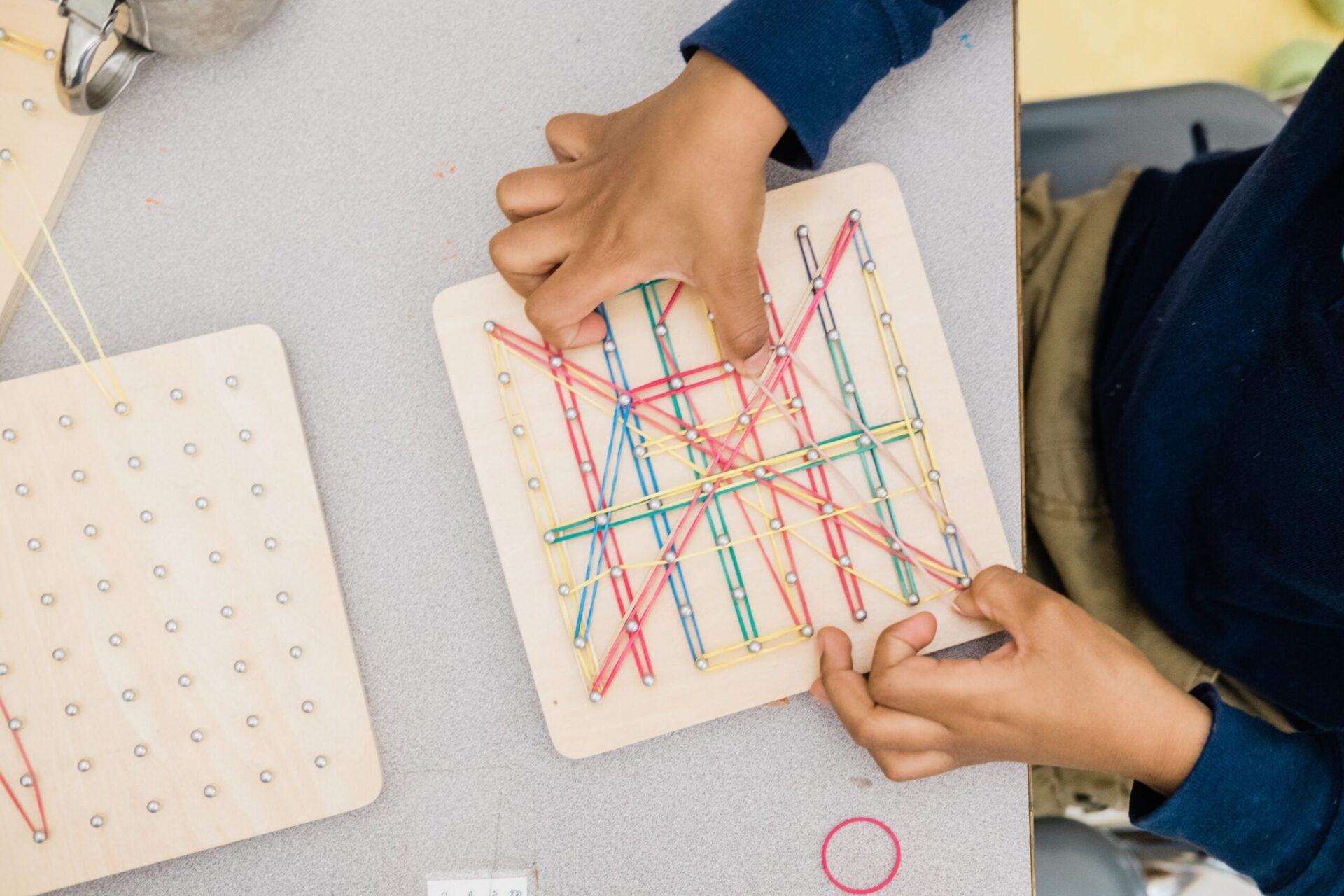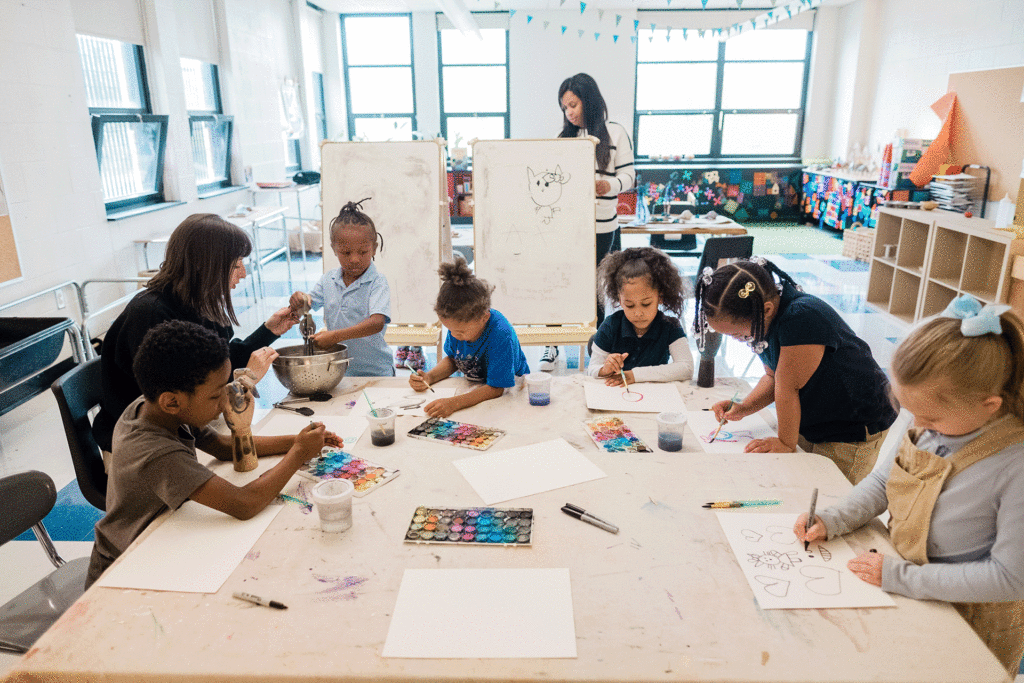For millennia, humans have learned through play. And yet in too many of today’s early learning settings, playful learning has been replaced by a rigid emphasis on math and literacy skill-building. With encouragement from Hatch teaching artists Shannon Merenstein and Dahlia Rao, kindergarten and first-grade students at Faison K-6 Elementary School are developing their ability to explore literacy, math and so much more – all through the power of play. Through carefully crafted play-based teaching strategies these young children are also building meaningful relationships and vital social-emotional skills as they joyfully create, problem-solve and journal about their play experiences.
But perhaps most impactfully, Hatch Partners in Play is also helping teachers at Faison shift their mindsets and their school’s culture. With the support of a Moonshot grant from Remake Learning, play-based experiences are reshaping educators’ understanding of the children they teach by vividly demonstrating what young children are capable of, how fully they can pursue self-driven and authentic inquiry-based learning, and how much they can contribute to the learning experience. These adults are finding new and much-needed joy in their own work, and they are beginning to spread this understanding throughout their school building and beyond.
Who
Merenstein and her Hatch colleague Harrison Smith applied for their initial Moonshot Grant in 2021 with a clear vision for the project. But by choice, they took time in choosing the educators who would serve as their partners.
Among their priorities:
- Partnering with a public elementary school that was serving families from communities of color
- Partnering with educators who would not use play as a reward for good behavior or withhold it as a consequence for bad behavior
- Ensuring that teachers would commit to a daily time of play, with the understanding that this play would reinforce other kinds of learning rather than function as a break from learning
- Ensuring that students wouldn’t be pulled from periods of play for interventions or other services
After interviewing a number of potential collaborators, they met three teachers from Faison K-6 who all had what Merenstein describes as “a really full view of children” and a strong belief in what even the youngest learners can accomplish through open-ended play.
They are:
- Jerone Morris, a first-grade teacher and longtime resident of Pittsburgh’s Homewood neighborhood, where Faison is located
- Katy Carroll, a veteran and award-winning Pittsburgh Public Schools teacher currently teaching kindergarten
- Renata Capozzoli, a kindergarten teacher who has been using play-based curriculum throughout her career and is affiliated with the Fred Rogers Center
These three educators brought a range of experiences and strengths that were perfect for this project.

Faison was also a great candidate because it is a public elementary school serving families from communities of color in an under-resourced neighborhood. In many communities throughout the country, socioeconomic barriers prevent children from experiencing creative play opportunities.
This project is centered on the notion that creative play is a fundamental need and right for all children. True play prioritizes the humanity of every child, and should be used to cultivate inquiry, cooperation, conflict resolution and community involvement among all of our region’s students.
“It’s really powerful to be able to see this in action in a school like Faison,” Rao says, “and to see educators taking these ideas and using them in ways that are most meaningful to them, and bringing them to other educators in the community.”
Another key: The school’s principal, Dr. Russell Patterson, enthusiastically supported the project. Along with welcoming the Partners in Play project into his school’s kindergarten and first-grade classrooms, Patterson advocated for Partners in Play “putting down roots” within Faison. Once the project was approved for a second grant in 2022, this led to the opening of a dedicated “Playlab” in the building, which serves not just the entire K-1 cohort of students but also serves as a place for teachers to develop their skills in assisting play.
Patterson also sees Partners in Play as a resource for educators throughout the region, something Rao says emphasizes the far-reaching nature of this project.
Centering this work in the community of Homewood “shows that it’s not out of the reach of any educator to do this,” she says. “It’s unique, because a school like Faison isn’t typically at the center of the professional learning network.”
Why
Play is intuitive to all human beings, Merenstein says, and it is essential. People of all ages crave agency, autonomy and the freedom to explore, create and imagine new possibilities. We also crave the chance to develop relationships and to interact authentically, and that is exactly what transpires during child-led, open-ended play.
Without that, Merenstein says, research has shown that school can be a dehumanizing experience that creates a deficit sense of self within the community.
By embracing the spontaneity and innovation inherent in young learners, rather than limiting them in an atmosphere of assessment and comparison, child-led play leads to a future where students trust themselves and develop a positive academic self-image through their own creative discoveries and accomplishments.
This preferred future is now emerging at Faison on a daily basis through Partners in Play.
Just one example: One day last year, a student named Jacouri came to the Playlab feeling sad because a student teacher he had befriended would soon be leaving Faison. Given a choice of how to spend his time, he gravitated to the Playlab’s geoboards – wooden boards with nails arranged in gridlines. He chose to begin arranging rubber bands along the nails, first choosing his favorite colors and then stretching the bands to form some of the letters his class had been learning.
He soon progressed to experimenting with more complicated letters, creating curves for the letter J from his own name, and making angles for the letter A. He began bringing his board around the Playlab to show classmates that he had formed the first letters from their names. Their positive responses to his efforts lifted his mood and strengthened his connection to these classmates. And as he sat down to think about and journal about his experience through drawings (a key part of this play-based learning process), he sat with the student teacher to reflect together.
“I learned the ABCs,” Jacouri told the student teacher, “and worked on my name and made letters for my friends… AND YOU!”

What
During play sessions, students have free access to a range of materials – things like clay, wooden blocks, magnatiles, paints and more – which they are encouraged to combine in new and creative ways. This method of combining materials in new ways and introducing new materials is drawn from the Reggio Emilia approach to learning.
The consistency of these materials is important, so that the children feel confident that they can choose a given item knowing that the other items will be available next time. “We want them to feel like it isn’t the only time they get to touch something,” Merenstein says.
After students have played for the majority of an hour, they are given time to journal about their creative experiences by drawing pictures or writing about their play. This reinforces a child’s sense that their thoughts and feelings have value and that the play they’ve been enjoying also has value totally unrelated to any grading or comparison to the work of others.
The journal “becomes this longitudinal record of their curiosity and work over the course of the year,” Merenstein says. “It’s a really beautiful sort of arc of learning that we get to see.
The daily journal is also a reminder to the students that they will return again and again to the experience of play, and that they can continue reflecting on discoveries they made during that experience.
In the three classrooms where this work has been piloted, Morris, Carroll and Capozzoli run daily play sessions with their students. Each of those teachers brings their own expertise and lens. For Morris, this includes a keen interest in Black identity. For Carroll, a focus on literacy. And for Capozzoli, an embrace of hands-on maker learning.
In the dedicated Playlab space, Merenstein and Rao currently run six Playlab sessions per week, and are looking to bring the experience to the entire lower school at Faison. And they have begun branching out beyond Faison to do two Playlab sessions each week at Arsenal school in Lawrenceville.
Shifts
The project has sparked a range of individual and institutional shifts at Faison.
- Broad interest has grown across the school’s faculty about the power of play.
- Teachers are relating to students in new ways after seeing each young child as an individual pursuing their own curiosity and connecting meaningfully with each other through play. “Once you see these children building these relationships with the teacher and with other children, you can’t un-see it,” Rao says. “And so in the classroom, you can’t treat them like a cog.”
- There has been a visible transformation in the way the school environment looks. “Play stories” with descriptions and vibrant photos of the children playing are displayed around school hallways. This has created an inspiring landscape for students and drawn the interest of a growing number of administrators and teachers.
- Students are building stronger literacy skills as they enthusiastically journal about their experiences immediately after playing.
Why It’s Working
Mindset: Teachers and administrators saw themselves as pioneers and embraced the work of innovating. Everyone involved, Merenstein says, saw themselves as constantly learning, and together they co-created new routines and rituals to give flexible structure to this work.
Support from additional partners: Patterson, the school’s principal, has advocated for the project and was enthusiastic about creating a professional development space for educators to really discover what it means to prioritize play. In addition, Merenstein and Rao credit Dr. Denisha Jones and her research team for supporting their focus on equitable learning and meticulously documenting the academic and social emotional benefits of play for young children. In the grant’s second year, the team has partnered with Dr. Katrina Bartow Jacobs and her team of graduate assistants from the University of Pittsburgh’s School of Education. They are continuing the work of collecting photos, video and additional data through play journaling and play stories to document the benefits of play.
Visible progress: Participating teachers could quickly see the value of play-based learning for their students and themselves. They also found real joy in experiencing the children and learning from them as they embraced the experience of truly free play.

Barriers Encountered
Given the enthusiasm of all partners, this work has progressed with few barriers. But one challenge has been reshaping educators’ idea of what kids can contribute to the learning environment.
It’s been a big, and at times uncomfortable, experience for some teachers to sit back and allow free play to unfold without direct guidance, Rao says. Teachers must grapple, she says, with the question “what is my role in the space, if it’s not to stand in the front and direct the experience?”
But as they stick with the process, those teachers make powerful discoveries.
“When you have the opportunity to actually learn from the children and with them in play experiences, you see a completely different side of the children but also of yourself,” Rao says. “I think that educators need more of that in their world right now.”
Another challenge: Showing the wider learning community what kindergarten and first grade currently look like in most public schools, and developing an understanding of why play is so essential, especially for children in underserved communities.
Merenstein describes this as more of an ongoing part of this effort, rather than an actual barrier.
“It’s just a big part of the work, helping folks understand what kindergarten and first-grade could look like,” she says, “and what they currently look like in many, many settings.”
Advice From This Project for Like-Minded Efforts
There is great value in pairing contrasting strengths: Merenstein and Rao came had years of experience educating outside the K-12 structure, having operated an art and play studio for six years prior to the pandemic. Their knowledge of and experience with play-based inquiry brought what is traditionally thought of as a out-of-school-time mindset directly into the classroom.
By making data collection a central thread of a project like this, leaders can document the academic and social-emotional benefits in real-time, which helps to further improve the project as it progresses.
Communities do not need to separate and isolate the skills of creativity and imagination by categorizing them as additional, optional enrichment offered outside the school day. That siloing denies students from less affluent families the vital experience of play, further reinforcing inequities. Instead, imaginative play can be threaded throughout the school day for all students.
Cultivating your agency and autonomy within the school day helps children learn, and helps them feel seen, known and heard. This facilitates their capacity to build relationships with their peers and with adults at their school in ways that might not happen without the chance to express themselves creatively.
Authored by

Melissa Rayworth
Melissa Rayworth has spent two decades writing about the building blocks of modern life — how we design our homes, raise our children and care for elderly family members, how we interact with pop culture in our marketing-saturated society, and how our culture tackles (and avoids) issues of social justice and the environment.
